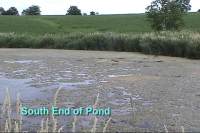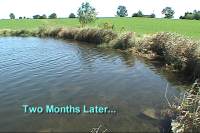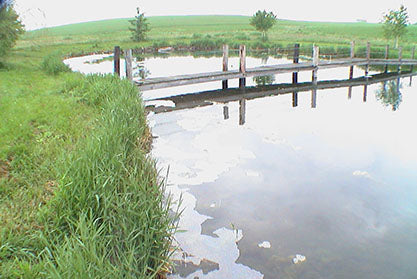
Case Study: Rossi Farms Pond
Problem
A 1 ½ acre farm pond located in southeastern Wisconsin was experiencing a severe algae bloom due to high levels of fertilizer runoff from the surrounding farm fields located on the north and east sides of the pond. Farm field runoff drains into the north end of the pond via a 4-inch drainpipe. The pond is further fertilized by the year round population of 6-8 resident ducks and by migrating waterfowl in the spring and fall of the year.
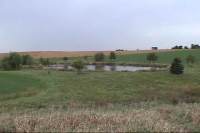
The pond was created by placing an earthen dam in the gully of the surrounding farm fields. Average water depth is 4-5 feet deep with an 18-foot hole located in the center of the lake. The periphery of the pond averages only 18 to 24 inches in depth for the first 6-10 feet from the shoreline, thus contributing to algae problems. The pond also has a small shallow cove that is a maximum 2-foot in depth. Water levels in the pond are regulated by an overflow pipe at the southern end of the lake.
Treatment Objectives
The objectives were to treat the Rossi Pond with the use of Great Lakes Bio Systems and MixAir Tech products only. Use of algaecides or other related products was not considered for this project. The goal was to document the treatment results and confirm the effectiveness of the Orb-3 and MixAirTech products.
Treatment began on July 5th, 2000 and was considered completed on September 7th, 2000 after it was noted that all algae had dropped from the water column and water clarity improved by 48 plus inches.
Equipment Used
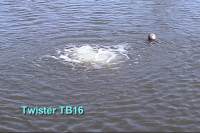
The Rossi Pond project utilized a MixAir Technologies aeration system. The blower unit consists of a ¾ HP Gast Rotary Vane blower capable of producing 10 PSI and 10 CFM of air. A 3 way manifold was used to allow individual control of each diffuser. An internal industrial strength fan helps cool the internal air temperature an additional 30°- 40°F.
Three MixAir Technologies TB16 diffusers were utilized for this project. One TB16 unit was located at the southern end of the Rossi Pond in the 18-foot hole. The second TB-16 was located in the northern third of the pond and the third TB16 unit was located at the opening of the cove.
All piping from the blower was done with ¾ inch PVC pipe and was buried underground to the waters edge. Piping extended to the general location of the diffuser. PVC to diffuser attachment was completed with ½ I.D. reinforced clear plastic pipe. Approximately 3 CFM of air passed through each diffuser.
Chemistry Used
Two Great Lakes Bio Systems products were used for actual remediation of the Rossi Pond: Orb-3 Professional Enzymes and Orb-3 Professional Dry Bacteria in 8-ounce dissolvable pouches.
The Orb-3 Professional Dry Bacteria were fed weekly at a rate of 3 pounds per acre-foot. The Orb-3 Professional Enzymes were fed weekly at a rate of 1/2 gallon diluted with tap water and sprayed topically with a 5 HP Briggs and Stratton pump and a fire hose.
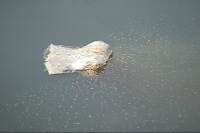
Treatment with the Orb-3 Professional Enzyme product was limited to topical spraying of the algae during the first 6 weeks of application, thereafter personnel treated with Orb-3 Professional Enzymes in a variety of concentrations and spraying methods. This was to determine if better and/or faster results were possible with the enzyme technology. These treatment methods were performed until September 7th when the project was essentially completed. Since then the Rossi Pond is being maintained using 1½ gallons of Orb-3 Professional Enzymes and 2 pounds of Orb-3 Professional Dry Bacteria bi-monthly.
Results
An analysis of the Rossi Pond showed an algae mat that extended 3 to 4 feet from the shoreline. Thirty-six hours after treatment a site visit revealed that the algae mat turned from a vibrant green to a neutral brown in the areas that were sprayed. Two weeks after the initial treatment the entire algae mat had turned a light brown in color as the Orb-3 Professional Enzymes product worked its way into the water column and began to affect the entire column of algae. Water clarity improved from 12 inches prior to treatment to approximately 24 inches in three weeks. It was further noted that the algae column began to sink in areas that were heavily sprayed with the Orb-3 Professional Enzymes product.
Four weeks after treatment began the blower unit failed for three weeks. Due to this period of inactivity, the diffusers needed to be serviced and maintained according to the ”Operation Maintenance Guidelines”. It should be noted that during the time of diffuser failure the algae mat extending from the shoreline increased 2 to 3 times in distance, in some cases extending an estimated 30 feet from shore.
During week 6 and week 7 personnel began to experiment with feeding of the enzyme product. During this time personnel sprayed 2 gallons of concentrated Orb-3 Professional Enzymes product onto the mat of brown algae. The purpose of this was to determine if the algae mat would sink faster by using a more concentrated dosage. As an easy comparison and to minimize outside influence, approximately 1-2 gallons of product was sprayed onto half of “the cove”. The water column in this bay averages 1½ feet with some spots reaching 2½ feet near the mouth of “the cove”.
After approximately 1-2 weeks a distinct division was noted between the sprayed and un-sprayed areas of the cove. Of the sprayed area ½ of the algae completely sunk near the center of “the cove”. No fish kill was observed during or after use of the neet Orb-3 Professional Enzymes product.
